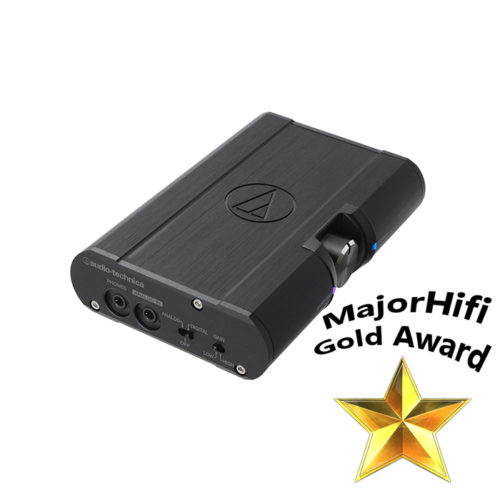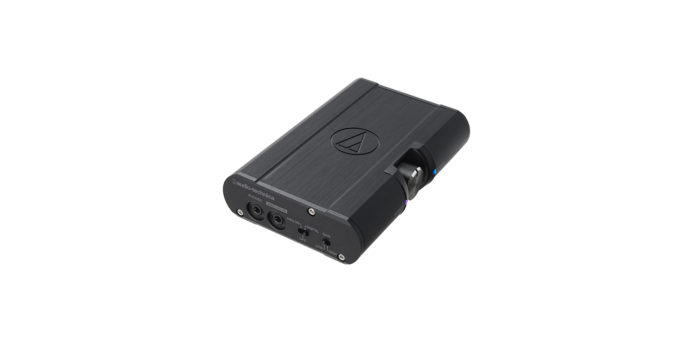Audio Technica’s newest portable headphone amplifier, the AT-PHA100 is a relatively small device packing quite a punch. But with a pricetag of $549, how much punch do you get for your money?
Audio Technica AT-PHA100 Amplifier Review

Featuring a brushed aluminum body and plastic front and back plates, the PHA100 feels solid in my hands – and a little weighty, too. On the front plate, there’s a 3.5 mm headphone output jack, a 3.5 mm analog input jack, a power switch for changing the input to digital or analog (or for turning it off altogether), and a switch to change gain from low to high.
On the right hand side of the unit, there is a large knob for volume adjustment.
The back plate sports a switch for PC use or battery operation. Located directly to the right of this switch is a micro-USB port that works as either a digital input or a charging port, depending on the switch settings.
Specs
System Requirements: PC: with built-in USB port corresponding to USB 2.0
CPU: Intel Core2 CPU2.2 GHz or equivalent
RAM: 32-bit OS 2 GB or more, 64-bit OS 4 GB or more
Supported OS: Windows XP (32-bit)*, Windows 7, Windows 8, Windows 8.1
Mac OSX Mavericks (10.9)
* Technical support by Microsoft is no longer available.
Corresponding Headphone Impedance: 10 – 300 ohms
Maximum Output Level: 100 mW + 100 mW (10% during 16 ohms, THD)
80 mW + 80 mW (10% during 32 ohms, THD)
10 mW + 10 mW (10% during 300 ohms, THD)
Frequency Characteristic: 10 Hz – 100 kHz (-1 dB)
Signal-to-noise Ratio: 110 dB (A-weighted)
Total Harmonic Distortion: <=0.001% (32 ohms 10mW output)
Input Connector: Analog: 3.5 mm (1/8″) gold-plated stereo mini jack
Digital: USB (micro-B)/asynchronous mode/
DSD128 (DoP), DSD64 (Native / DoP): 24 – 32 bit/
PCM 384kHz, 352.8kHz, 192kHz, 176.4kHz, 96kHz, 88.2kHz, 48kHz, 44.1kHz, 32kHz: 16 – 32 bit
Output Connector: 3.5 mm (1/8″) gold-plated stereo mini jack
Power Supply: 5V DC, 500 mA bus power system (PC)/rechargeable lithium polymer battery (BATTERY)
Charging Time: Up to 10 hours (DC5V, 500mA)
Battery Life: Digital about 6 hours (JEITA) / analog about 14 hours (JEITA)
Operating Temperature: 41 – 104° F (5° – 40° C)
Dimensions (excluding protrusions): 1.1″ (27 mm) H × 3.0″ (77 mm) W × 4.6″ (116 mm) D
Weight: About 240 g
Whew! That’s quite the spec sheet we’ve got, folks! While you could peruse that at your leisure, I can also give you the key details: the amplifier should handle any headphone with an impedance between 16 and 300 ohms, there’s very little distortion in the sound, and it has a decent battery life. It is also worth mentioning that this amp could act as a DAC when used with PC input, and sampling rates include the whole spectrum of quality, from compressed, uber-sucky 32 kHz MP3s to delicious DSD files.
Sound
Audio Technica claims very low distortion on this amplifier. And from what I can hear, that’s pretty much the truth. There’s no real coloration to the sound, but perhaps things do sound a little sharper or more defined. Perhaps. Or maybe that’s just the sound of my headphones being properly driven for the first time in, well, ever.
Compatibility
Compatibility is pretty wide open, with all but the most heavily-impeded headphones able to take advantage of the PHA100. Of course, that means the 600 ohm Beyerdynamic T1 won’t be a good fit, nor will Audio Technica’s own 470 ohm R70X. But the fact that this amp can handle anything up to 300 ohms still leaves you with a lot of options. For this review, I paired it with the Beyerdynamic DTX1770 (250 ohms) and the Jays Q-Jays (45 ohms).
Overall Impressions
The Audio Technica AT-PHA100 is one snazzy looking amp. It’s a little bulky, even when paired with my brick-like FiiO X5 II. But bulk aside, it just looks and feels so damn sexy. Clearly, a premium portable amp like this isn’t going to have much competition, but if I had to throw a model into the running, I’d nominate the Chord Mojo for the job.
While the Mojo offers more compatibility (being able to drive a headphone between 8 and 800 ohms, and offering two headphone outputs), the Mojo also offers digital coax, micro USB, and optical inputs, but doesn’t offer a basic analog input. It’s also more utilitarian in appearance.
The PHA100, in contrast, won’t power anything beyond 300 ohms, but it does give you the micro-USB and analog inputs, as well as a sleeker, more sophisticated appearance. If we miss anything on Audio Technica’s amplifier, it’s the inclusion of high quality inputs, like digital coax and optical.
In my opinion, the Audio Technica AT-PHA100 is a friendlier amp for beginners, being easy to use without many of the quirks of higher-end options, and sporting some eye-popping good looks. Even though it lacks as wide of a range of input options as the Mojo, it still does a great job as a portable amp. And who really needs two headphone outputs, anyway? If you’re going to listen to the Beyerdynamic T1 or something with similar power requirements, sure, get a more powerful amplifier. Otherwise, the AT-PHA100 is where it is at. Even though I have a desktop amp at home, and have no real need for a portable amp, I still want to own this baby.
Now I just need that $549.

Compare the ranking of various headphones, earbuds and in-ear monitors using our tools.
Discuss this, and much more, over on our forum.
---MAJORHIFI may receive commissions from retail offers.















